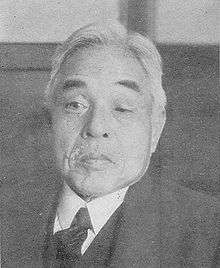Shakai Taishūtō
Shakai Taishūtō 社会大衆党 | |
|---|---|
| Leader | Abe Isoo |
| Founded | July 24, 1932 |
| Dissolved | July 6, 1940 |
| Succeeded by | Imperial Rule Assistance Association |
| Headquarters | Tokyo |

The Shakai Taishūtō (社会大衆党 Socialist Mass[es] Party or Social Mass[es] Party) was a moderate leftist political party in early Showa period Empire of Japan.
The Shakai Taishūtō was founded by Abe Isoo in July 1932, as a merger of the Shakai Minshūtō (Socialist Mass Party) with the Zenkoku Rōnō Taishūtō (National Labour-Farmer Mass Party).[1] In a period of increasing extremism in politics, the new party attempted to maintain a middle-of-the road approach, which inevitably resulted in a confused policy.
On one hand, the Shakai Taishūtō supported agrarian reform and pushed for improvement in the lot of the farmers by cutting the military budget; on the other hand, it cultivated ties with the Tōseiha political faction within the Imperial Japanese Army, and supported Japanese aggression in Manchuria. The Shakai Taishūtō advocated increased international cooperation and opposed Japan's withdraw from the League of Nations, but at the same time supported the invasion of China in 1937.
It was the only leftist party allowed to function in the 1930s, it emerged as the third largest party in the Lower House of the Diet of Japan, with 36 seats after the 1937 General Election. The party received support from a wide cross-section of the electorate, including middle class shop owners resentful of the zaibatsu, salaried-workers, and some minor bureaucrats.[2] However, the basic split within the Shakai Taishūtō internally between supporters of social democracy versus national socialism came to a head after the vote to expel Saitō Takao from the Diet arose after he sharply criticized the conduct of the Imperial Japanese Army and its actions on the Asian mainland. Members of the party who had abstained from the motion to purge Saitō were expelled for “unpatriotic sentiments”, causing chairman Abe Isoo to resign as well.[3] The remainder of the party grew increasing nationalistic and militaristic, and was absorbed into the Imperial Rule Assistance Association in 1940.[4]
References
- Scalapino, Robert (1962). Democracy and the Party in Prewar Japan. University of California Press. ASIN B0007FP0H6.
- Large, Stephen S. (2010). Organized Workers and Socialist Politics in Interwar Japan. Cambridge University Press. ISBN 0521136318.
- Sims, Richard (1990). Japanese Political History Since the Meiji Renovation 1868-2000. University of California Press. ISBN 0520068386.